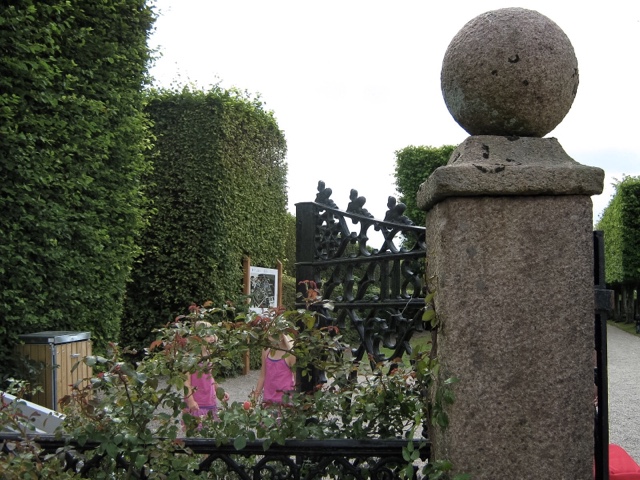Egeskov is one of the best preserved Renaissance water castles in the world. It is situated in the south of Funen, the third largest island in Denmark. Although there was mention of Egeskov as early as 1405, construction of the actual castle began in 1554. In response to civil unrest caused by the Count's Feud, a conflict that took its name from the Protestant Count, Christopher of Oldenburg, and the hostilities around the Protestant Reformation, many Danish noblemen built fortified homes.
In 1554 Frands Brockenhuus, a vassal and a rigs marsk, a commander in the Danish Army, began building Egeskov on land that belonged to his wife of a year, Anne Tinhuus. It is said that an entire forest of oak was used to create oaken piles for the water castle to be built on in the centre of a small lake. The castle was, in fact, named Oak Forest, Egeskov. Not only was the water surrounding the castle used to fortify the structure, but a drawbridge, artillery ports, scalding holes and arrow slits were also part of the structure's defenses.
The castle was constructed using oversized medieval bricks called Monk's bricks. Consisting of two long buildings connected by a thick wall, Egeskov has round arched windows and gables. The double wall has a water well within it.
Frands Brokenhuus spent thirty years building the castle and, when he died, his son, Laurids, inherited Egeskov. In 1589 Laurids' daughter, Rigborg, was sent to the court of King Christian IV to serve as a Lady-In-Waiting for his wife, Anna Catrine. Rigborg became close to a young nobleman called Frederik Rosenkrantz the following year. She fell pregnant and gave birth to a son, Holger. Rosenkrantz was engaged to another woman, Christence Viffert, at the time. Laurids Brockenhuus demanded a trial, and Rosenkrantz was sentenced to exile after having two fingers on his right hand severed. The sentence was reduced and he was sent to fight in the war against Turkey. Rosenkrantz left for England and, apparently, became Shakespeare's inspiration for Rosenkrantz and Guilderstern, Hamlet's betrayers. Rosenkrantz later died in a duel in Prague.
Rigborg was sentenced to imprisonment in Egeskov. She was locked in a room for five years and her child was sent to live with his father's family. With the death of her father, Rigborg's mother appealed to King Christian IV to reduce her daughter's sentence. He allowed Rigborg to leave her room once a week to see a priest. In 1616, Rigborg's mother secured permission for her daughter to live on her own estates. This occurred in 1625 when her mother died. In 1626, Rigborg was reunited with her son Holger.
Egeskov passed through various families and, in 1784, it was sold to Henrik Bille, whose descendants have owned the castle ever since. Julius Ahlefeldt-Laurvig Bille moved into the castle in 1883. He renovated the castle with the help of Swedish architect Helgo Zettervall. The tower roofs were heightened and a gatehouse was built.
Egeskov was developed into a farm, with its own dairy, power plant and a railway to Kraerndrup. The castle has been open to the public for several generations and, in 1967, a Veteran Car Museum was opened in the barn. The Car Museum went on to expand into several other farm buildings. The Banqueting Hall was restored in 1975.
Since 1994, Michael and Caroline Ahlefeldt-Laurvig Bille have lived at Egeskov. The castle has become one of Denmark's most popular tourist attractions. The grounds have a renaissance garden with fountains and topiary figures. There is an English Garden, Herb and Vegetable Garden and an elaborate Water Garden. There are four mazes in the grounds of the castle, the oldest one being a Beech Maze. A three-metre-tall sundial in the castle grounds was especially designed by Danish poet and mathematician Piet Hein. There is also a wooden carving of Dracula in the gardens. A full-sized replica of Egeskov castle was built in Hokkaido, Japan, to serve as an aquarium.
Within the rafters of Egeskov castle, laying on a red velvet cushion, is a carved wooden doll which has been there since the castle was built. Legend has it that, if the doll is ever moved, the entire castle will fall into the lake it's built in on Christmas Eve. There have also been reports of strange noises coming from the parade armour that is on display.
I loved going to Egeskov. I initially went there to see the display of the famed dollhouse, Titania's Palace. Once I was there I was entranced by the beautiful castle and the spectacular gardens. Toys and all sorts of treasures are on display in the castle and on the grounds, including an amazing Car Museum. Egeskov is a magnificent place to spend some time.








































No comments:
Post a Comment